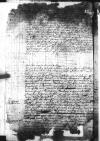List #3871
[Ioannes DANTISCUS] do [Tiedemann GIESE]Heilsberg (Lidzbark Warmiński), 1539-07-31
Regest polski:
Dantyszek kieruje do Giesego posłańca rady Gdańska z listem [zaadresowanym do Dantyszka i Giesego], jakkolwiek to jego samego gdańszczanie próbowali obarczyć przesyłką. Podniesione przez radę Gdańska postulaty uważa za słuszne. Prosi, by adresat uczynił im zadość i odpisał obszerniej, niż on sam to uczynił.
Poleca, by w ich wspólnym imieniu Giese napisał w sprawie rady Gdańska do króla. Dantyszek podpisze i opieczętuje ten list, gdańszczanie zaś pokryją koszty jego ekspedycji na dwór, jeżeli Giese pośle im kopię.
Przybyłego właśnie od Giesego [Eberharda] Rogge Dantyszek odeśle niebawem, po dokładnym omówieniu poufnych spraw.
Rękopiśmienne podstawy źródłowe:
Publikacje:
| ||||||
Tekst + aparat krytyczny + komentarzZwykły tekstTekst + komentarzTekst + aparat krytyczny
Reverendissime in Christo Pater et Domine, frater et paper damaged⌈[t]t paper damaged⌉ amice paper damaged⌈[amice]amice paper damaged⌉ ca paper damaged⌈[ca]ca paper damaged⌉rissime ac honorande.
Salutem paper damaged⌈[em]em paper damaged⌉ et paper damaged⌈[et]et paper damaged⌉ fraternam commendationem.
cf.
Heri a genti<li>bus nostris[1] cf.
Ea, quae in hac hostilitatis denuntiatione petunt[6], iusta sunt atque
Haec, quae in iis, quemadmodum petunt, ad
Quam diutissime incolumem etc.
Datum
Postscript:
Hac hora venit ad me dominus

 AAWO, AB, D. 7, f. 95v
AAWO, AB, D. 7, f. 95v